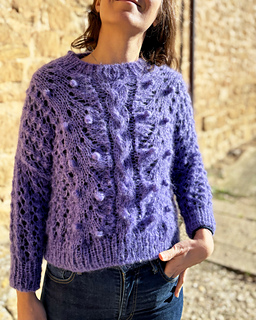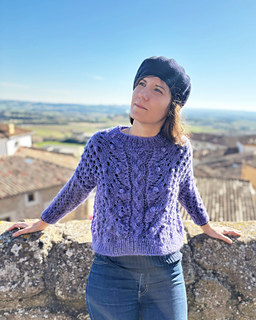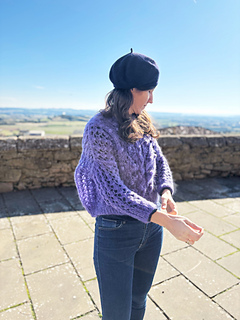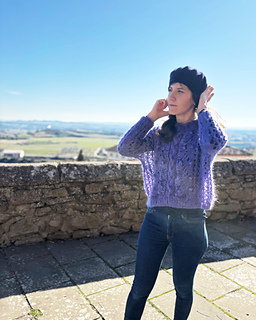patterns >  Esti Juango's Ravelry Store
Esti Juango's Ravelry Store
> Negua













Negua
INSPIRATION
Negua means winter in Basque. A time of meditation in which knitwear becomes our great ally and invites us to introspection. In this pattern you will find textures created by openwork, cable knits and bobbles. The repetitiveness of the pattern will turn the initial challenge into a structure of repetitions with which you will become familiar.
DIFFICULTY LEVEL. WHAT DO YOU NEED TO KNOW?
Intermediate. To knit, purl, make increases & decreases and to work in the round.
Pattern has been tech edited and tested
SIZES
1 (2, 3, 4, 5) (6, 7, 8, 9, 10) with final measurement of the sweater after blocking of bust width of 100 (110, 120, 130, 140) (150, 160, 170, 180, 190) cm/ 39.25 (43.25, 47.25, 51.25, 55) (59, 63, 67, 70.75, 74.75)”
Positive ease of around 15-20 cm/ 6-8”.
MATERIALS
• Yarn: Bilobila “Alfa” – 50 gr; 100 m (109,5 yds). 98% superkid mohair, 2% silk. Aran weight yarn. Link to the yarn.
• Amount: 4 (5, 5, 6, 6)(7, 8, 9, 10, 11) skeins of 50 gr
• Total in m: 400 (500, 500, 600, 600) (700, 800, 900, 1000, 1100) m
• Total in yds: 438 (547.5, 547.5, 657, 657) (766.5, 876, 985.5, 1095, 1204.5) “
• Circular 6,5 (US 10.5) mm needle to work in the round the body and sleeves
• Circular 5,5 (US 9) mm needle for the collar
• Markers. A different BOR marker. 4 locking markers
• Stitch holders
• Tapestry needle
GAUGE
In a 10x10 cm (4x4 in) gauge you should have 12 sts and 22 rounds worked with 6,5 (US 10.5) needles in lace back stitch, in the round. (Video- Knitty Natty Knitting Tutorials).
CONSTRUCTION NOTES
The pullover is started at the back neck and then increased to the full width of the back. After, those stitches are picked up along the sloped shoulders for the fronts. The pieces are joined at the underarm and the body is knitted in one piece in the round. The sleeve stitches are then picked up from the body and worked in the round. Stitches for the collar are picked up and worked with an elastic rib.
-----Spanish/ Español-----
INSPIRACIÓN
Negua significa invierno en euskera. Un tiempo de recogimiento en el que el punto se convierte en nuestro gran aliado y nos invita a la introspección. En este patrón encontrarás texturas creadas por calados, trenzas y bodoques. La repetitividad del esquema hará que el desafió inicial se convierta luego en una estructura de repeticiones con la que te familiarizarás.
REQUISITOS PREVIOS – NIVEL INTERMEDIO
Saber tejer derecho, revés, hacer aumentos y disminuciones. Tejer en circular.
El patrón ha sido testeado y editado tecnicamente
TALLAS
1 (2, 3, 4, 5) (6, 7, 8, 9, 10) con contorno de pecho en prenda bloqueada de 100 (110, 120, 130, 140) (150, 160, 170, 180 , 190) cm. Holgura positiva de unos 15-20 cm.
MATERIALES
• Lana: Bilobila “Alfa” – 50 gr; 100 m (109,5 yds). 98% superkid mohair, 2% seda. Grosor Aran. Ir a la web de bilobila
• Cantidad: 4 (5, 5, 6, 6) (7, 8, 9, 10) ovillos de 50 gr
• Total en m: 400 (500, 500, 600, 600) (700, 800, 900, 1000) m
• Agujas circulares de 6,5 mm para el cuerpo y mangas
• Agujas circulares de 5,5 mm para el cuello (cortas o largar para magic loop)
• Marcadores. Un marcador distinto para el inicio. 4 Marcadores de imperdible
• Imperdible o hilo adicional para dejar los puntos en espera
• Aguja lanera para rematar los hilos
TEJIDO DE MUESTRA
En una muestra tejida en circular de 10 x 10 cm en punto calado 12p por 22 vueltas. Ver vídeo (desde min. 9) para muestra circular. Bloquea la muestra para poder medirla. Teje una muestra de unos 15 x 15 cm, para poder contar bien la muestra en el centro.
NOTAS DE CONSTRUCCIÓN
La prenda se empieza en la parte trasera del cuello y luego se aumentan los puntos hasta alcanzar el ancho completo de la espalda. Después, esos puntos se recogen a lo largo de los hombros inclinados para los frentes, se montan puntos para el cuello uniendo los delanteros. Las piezas se unen en la sisa y el cuerpo se teje en una sola pieza en circular. Luego, los puntos de las mangas se recogen del cuerpo y se trabajan en redondo.
- First published: October 2026
- Page created: October 4, 2025
- Last updated: December 6, 2025 …
- visits in the last 24 hours
- visitors right now




